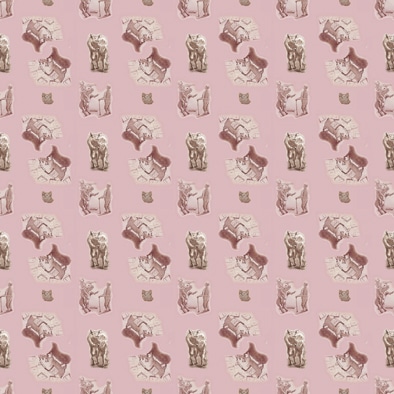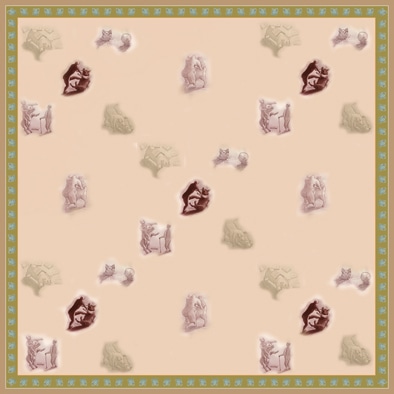How I work, an ongoing reflection
I often walk through my local landscape and draw. As I draw I reflect on what is happening in the community, often these reflections begin with a conversation. If you stand drawing in the street people will come up to you and ask you what you are doing and they usually then stop to talk about whatever is on their mind. These conversations often become the starting points for allegorical ideas. The drawings become points of reference within a growing larger set of images, images that become worlds in themselves. In the image below, older stories of pigs from my childhood in Dudley became entwined with newer stories that are embedded into a series of views of Leeds where I live now. Humans carry ammunition into the image, but animals (the pigs) confront them and they turn around and take the shells back to where they came from.
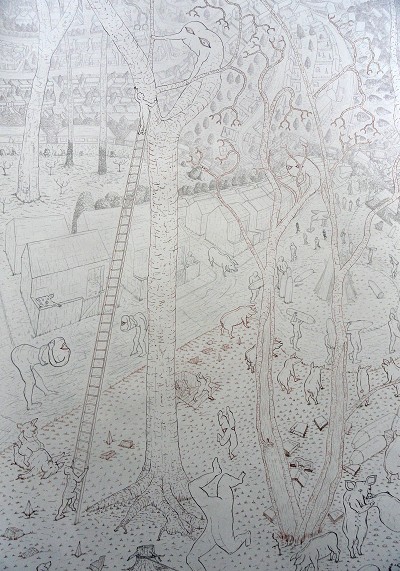
This large drawing, of which the image of of the central section, enabled me to use some of the cards I developed to help me generate ideas as to how images could be linked by narratives. I dealt cards out onto a just started drawing and their positioning suggested what could go into the image and where.
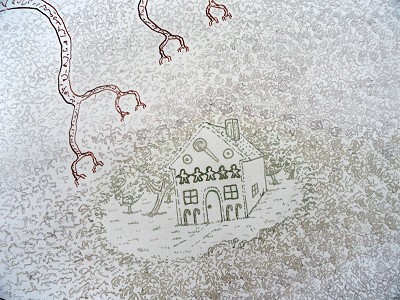
The first cards I made were simple hand drawn ones like this one below of a lifebuoy and I gradually developed the idea into a more formal one.
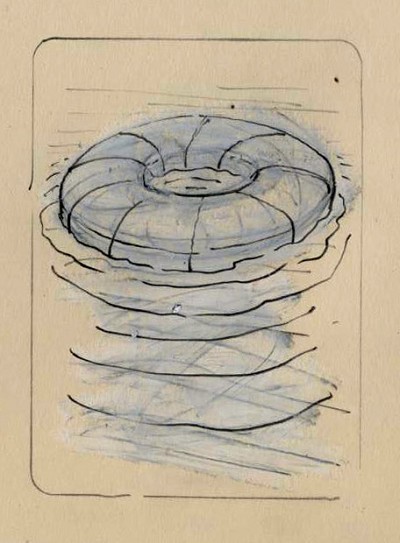
In order to visualise what I’m drawing and give the images more conviction I often make models, these are then used alongside the cards to spin off other ideas. This is not a logical process, more of a mash-up between different approaches, often interjected with poetry writing and more roaming the streets and drawing.
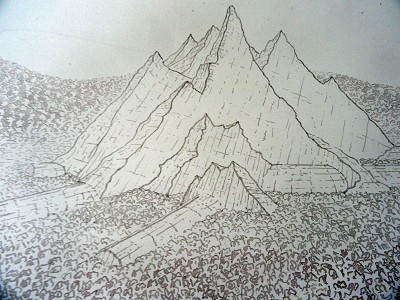
The blocks of card images were like many produced at the time, printed then cut up and placed on the drawings as they evolved. You can probably spot the trip hazard in one set and the ladder in another. Two images taken from ideas developed from snakes and ladders games, which ended up becoming embedded into the drawing above. A little like tarot cards I was using these images as triggers for stories and their being no fixed interpretation.

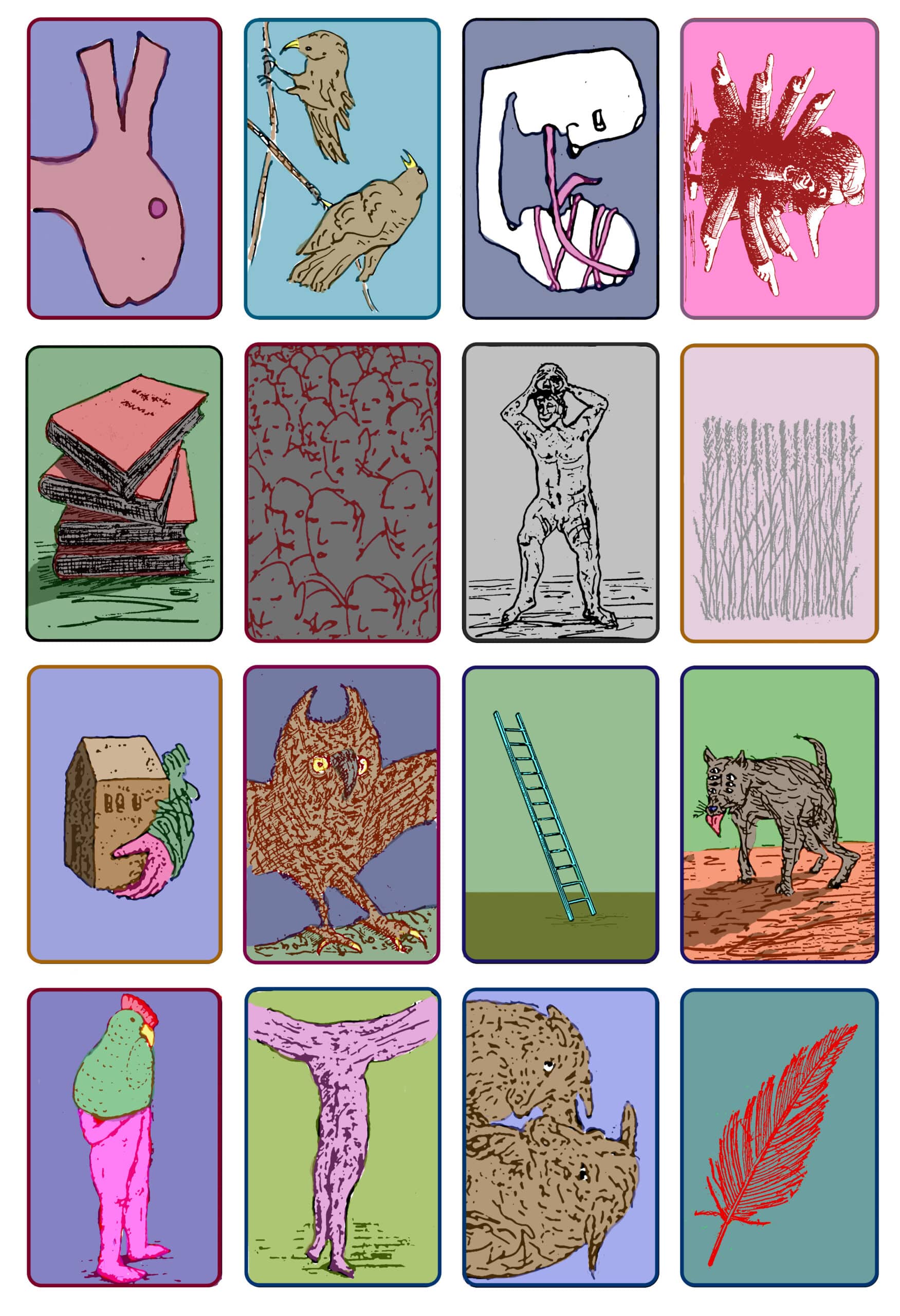
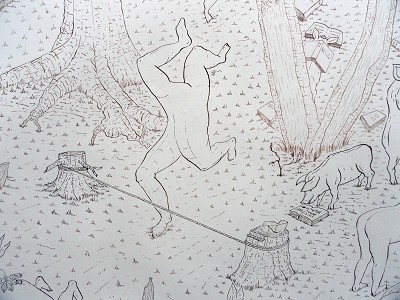
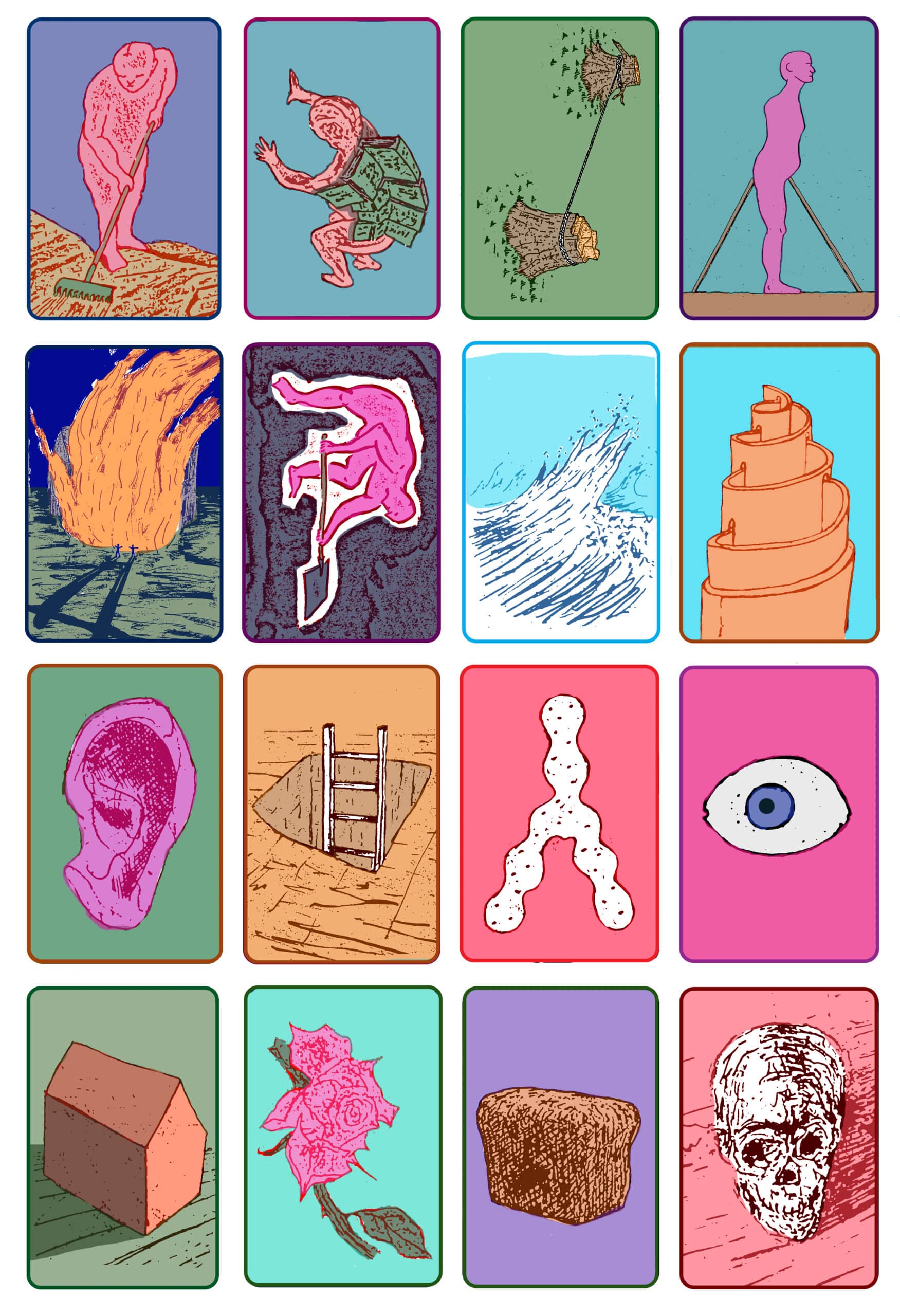
The sculptures of fire below enabled me to develop a series of 3D visualisations using 123D Catch.
I sometimes make small sculptures based on images taken from notebook drawings. I was looking at the formal and iconic potential of camp fires and mountains. A nagging worry about the confluence of healthy living, mountains, camp fires, boy scouting and the emergence of the Nazi party.
I scanned one of the models into 3D imaging software and developed it as an image for a print, (top right) the 3D net becoming a texture that seemed to turn the fire into stone. As it did the fire became the mountain top and the smoke became clouds. A plasticine model of a mountain top resulted.
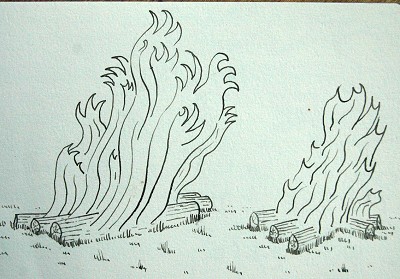
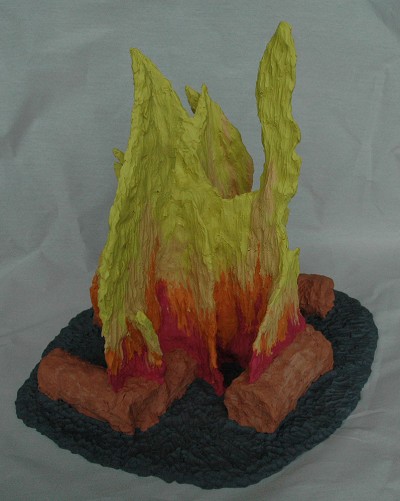
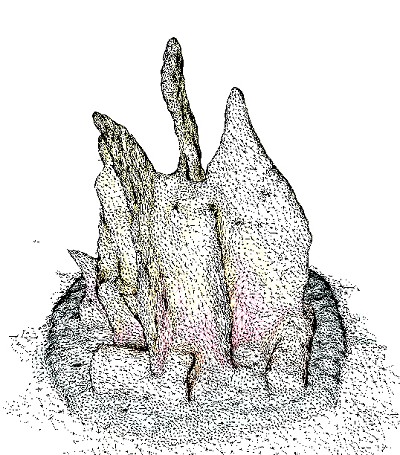

These drawings (below) are from an image just over 8 feet wide and as always drawings full of details on white paper are hard to photograph, so details will have to do. The image is a fusion of drawings made on walks through Chapeltown, images drawn from dreams, (I keep a notebook at the side of the bed for these) and worked out connections related to particular allegories that came to mind as I worked. Notice the image of a fire in the lefthand drawing, it will have been developed as part of the series of images above and then once its meaning established was in my mind, it was taken up as an ‘event’ within a much larger narrative.
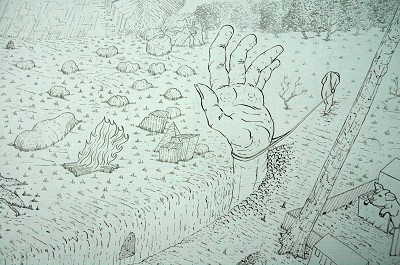
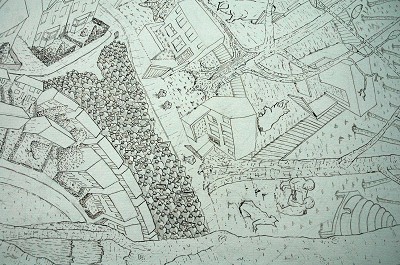

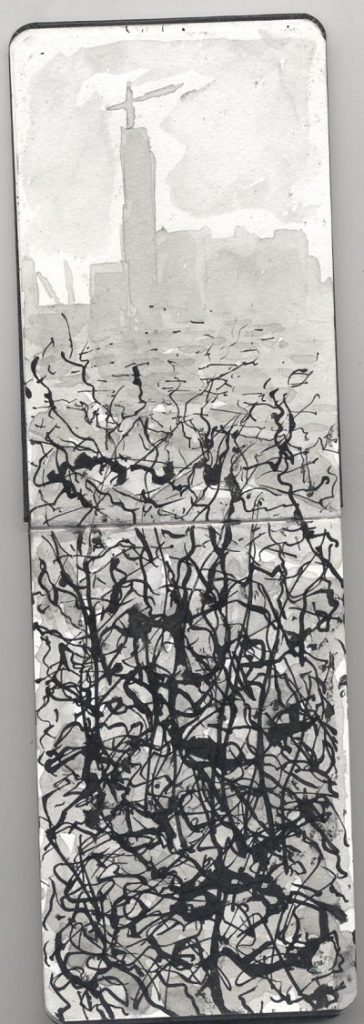
The drawing with a spiral tower emerging from its centre (below) began as an idea emerging from sketchbook drawings created on a series of walks around my local area. In this case the idea of the tower began as a simple grey shape in a very small drawing made on my way to work. I have dozens of notebooks like these which I refer to as I build the first part of a large image. The smallest ones are done directly from nature and then slightly larger drawings are done as I begin the process of making the drawings more ‘iconic’ or more generalised.
The one thing that ties them both together is that I use pen and ink for both. Very perverse I realise, but I started using a dip in pen in primary school and have loved them ever since.
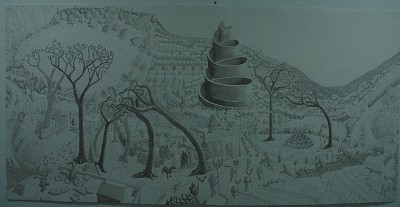
Details of the drawing above might make it easier to understand, its about 8 feet wide. Some of the images were drawn directly from Chapeltown carnival, which is where the giant praying mantis images came from. The trees became the drawing’s lungs.
In order to start I selected images that suggested a narrative. I was also trying to clarify a dream I had of a spiral tower which kept coming back, over and over again. The image started with a view drawn into a small sketchbook from just off Scotthall Road. But then the central image needed to go through a developmental process. It took a lot of work to make the spacial twist convincing.


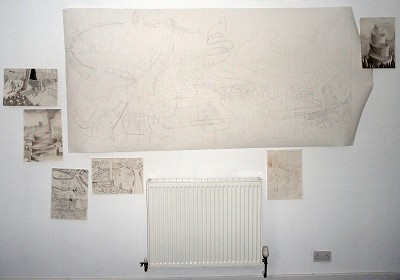
As I draw other types of ideas spin off. I just follow my nose and use the drawings to help generate either images in other media or further sections that need to be fitted together to create allegorical narratives.
Headscarf designs were one spin off, I’ve got about 10 done by now, the idea was at some point to have a complete show of them. Easier to look at www.spoonflower.com/fabric/1596858 if you want to get an idea of my designs for both headscarves and wallpaper.

I have made surface pattern designs from several of the pig images. The head scarves bring together images of my mother from the 1950s with images of my jewish grandmother and of women having to cover their heads in so many cultures. Pigs and religion a difficult mix, their ‘dirtyness’ perhaps a recognition of how similar they are to ourselves and also a reminder that because the pig has a split hoof, but does not chew the cud; it is unclean. I should therefore neither eat of their flesh nor touch their carcass.
I’ve drawn and printed images of pigs and men for several years now. Pigs float in and out of my imaginative landscape and perform different roles. See section on pigs for more of these.
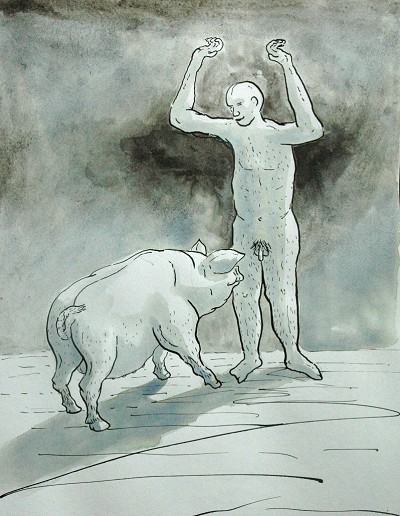

The image (below) is about 5 foot across, ink and water colour on paper.
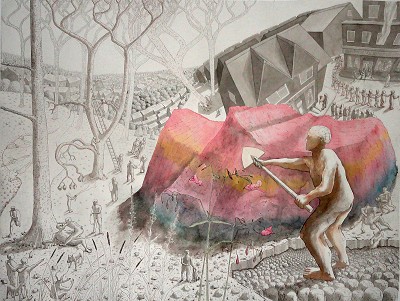
Below are details of various sections. I did some drawings of riots a few years ago directly from the TV, but the final image came from drawings I did of workmen digging up my local road. I became fascinated with piles of dirt and their potential to be transcendent. There was a particular time of the day when the sun was very low down near to the horizon, and its rays would catch the tops of piles of earth causing them to glow, and this reminded me of images of Ayres Rock, a mythic form that is central to Aboriginal Dreamtime. The other narratives were from my dreams I was having at the time about Hegel. I was dreaming about Hegel because I was then part of a reading group and we were studying aspects of his work. I mention this because it shows how anything can crop up as an influence on what you do.
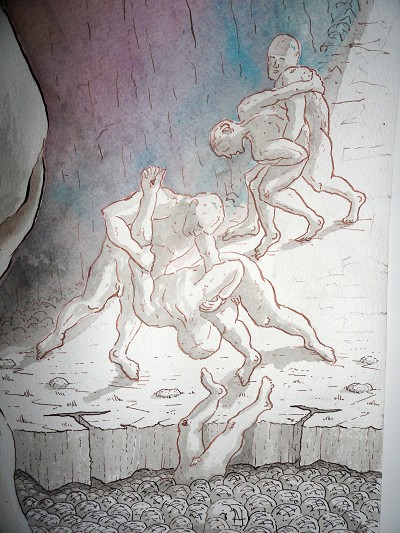
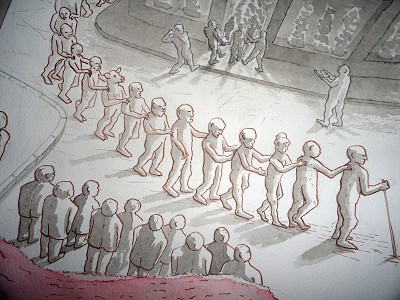
Details of isolated events within the image, which are typical of my drawings. In this case people are led past tragic events, but they are blind to what is happening
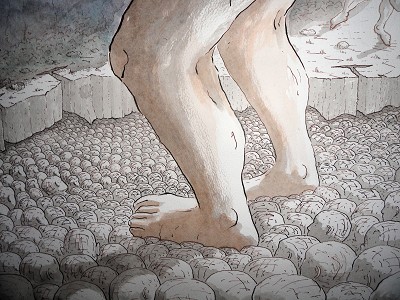
Some events are based on real life, others come from the imagined world that the larger drawing begins to suggest. Digging down began to suggest the digger breaking through into the Hell of past lives.
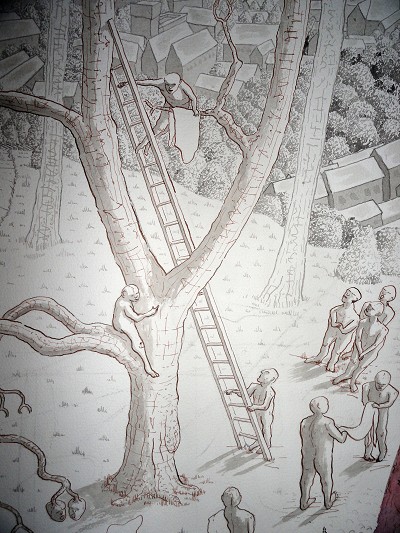
I was drawing flies for another image (see below), which has one scene of a cornfield and a man with a pig at the top (upside down) and a combined scene of two images I developed from drawing in the woods. Below are details of flies, drawn as the image began. The final image is about 8 feet high.


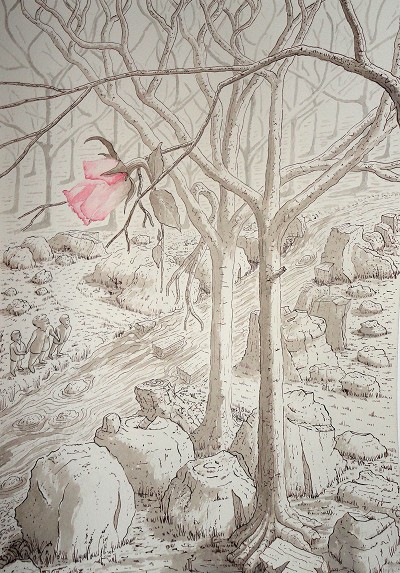
These two studies were combined to make up the bottom section, the flies rise up and finally pollinate a cornfield far above. The rose caught in the tree remained as a significant image, but the tiny people didn’t make the final cut.
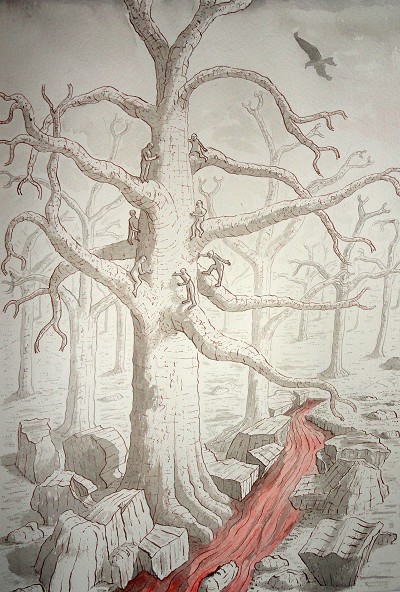
This is the finished image
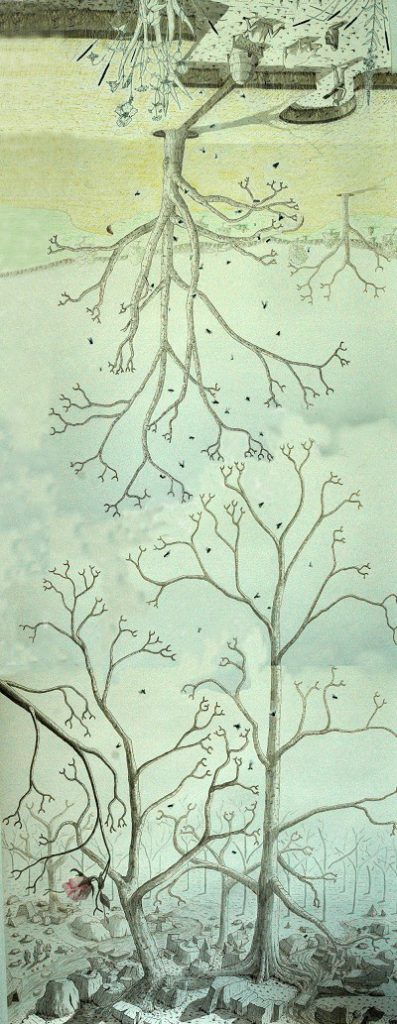
Not everything goes through a long gestation period. This is an image that arrived very quickly, no preparation, just stuck two sheets of A1 together and drew. Not sure about it, but it’s interesting in a dark way.
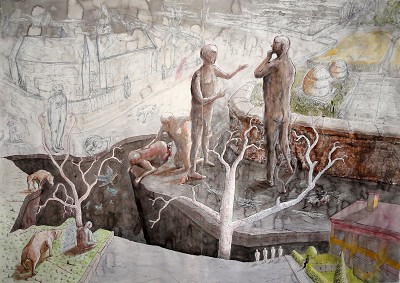
Although the images above are from work I was doing several years ago, the process of collecting information and gradually distilling it continues. What has though changed since these images were made, is that I am working far more collaboratively and using a much wider range of materials, in particular the way that clay begins to suggest new life almost as soon as it interacts with the hands, has begun to engage me more and more. Gradually ceramics has taken over a larger and larger slice of my making time, still subservient to drawing as a visioning tool, but only just.
The process is a very messy one, ideas collide and breed coming together at some points and diverging at others. What unites them is though drawing. I draw everyday if I can, either to build up visual reference points or to allow ideas to emerge. Both sorts of drawing energise each other. The more I draw from life the more I can control the emergence of ideas as they emerge from the drawing mind. The more objects I make to help visualise my drawings the more these objects take on a life of their own and eventually become starting points for works in their own right.




